Netherlands Marine Corps
The Korps Mariniers is the elite infantry component of the Royal Netherlands Navy. The unit is specialised in special operations, operating under highly extreme conditions and amphibious warfare. The Korps Mariniers are a rapid reaction force that can be deployed to any location in the world within maximum 48 hours. Their motto is Qua Patet Orbis ("As Far As The World Extends").
| Netherlands Marine Corps | |
|---|---|
| Korps Mariniers | |
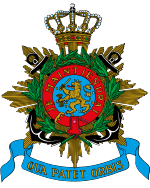 Badge and Insignia of the Korps Mariniers | |
| Active | 10 December 1665 – present (354 years, 8 months) |
| Country | |
| Branch | |
| Type | Naval Infantry Special Operations |
| Role | Expeditionary Force Rapid Reaction Force Special Operations Force |
| Size | ~ 2000 |
| Garrison/HQ | 1 Marine Combat Group – Doorn 2 Marine Combat Group – Doorn Special Operations Unit – Doorn 32nd Raiding Squadron – Aruba Surface Assault and Training Group (SATG) – Texel |
| Nickname(s) | "The Black Devils", “Men of Steel” |
| Motto(s) | Qua Patet Orbis ("As Far as the World Extends") |
| Colors | Navy Blue, Red |
| Anniversaries | 10 December 1665 |
| Engagements | Second Anglo-Dutch War Third Anglo-Dutch War War of the Spanish Succession Battle of Texel Battle of Seneffe Battle of Dogger Bank Bombardment of Algiers Rotterdam Blitz Battle of the Java Sea Battle of Java Iraq War War in Afghanistan |
| Commanders | |
| Current commander | |
| Notable commanders | Willem Joseph van Ghent |
History
The Corps was founded on 10 December 1665 during the Second Anglo-Dutch War by the Prime Minister of the Dutch Republic, Johan de Witt, and Admiral Michiel de Ruyter as the Regiment de Marine. Its leader was Willem Joseph van Ghent. The Dutch had successfully used ordinary soldiers in ships at sea in the First Anglo-Dutch War. It was the fifth European Marine unit formed, being preceded by the Spain's Infantería de Armada (1537), the Portuguese Marine Corps (1610), France's Troupes de marine (1622), and the English Royal Marines (1664) but the first corps in history to be specialised in amphibious operations. Like Britain, the Netherlands has had several periods when its Marines were disbanded. The Netherlands itself was under French occupation or control from 1810 until 1813. A new Marine unit was raised on 20 March 1801 during the time of the Batavian Republic and on 14 August 1806 the Korps Koninklijke Grenadiers van de Marine was raised under King Louis Bonaparte. The modern Korps Mariniers dates from 1814, receiving its current name in 1817.
The battle honours as they appear on the Korps Mariniers' colors are:
- Spanje - Algiers
- West-Indië
- Seneffe
- Kijkduin - Doggersbank
- Bali - Atjeh
- Chatham
- Rotterdam
- Javazee
- Java en Madoera
- Nieuw-Guinea
- Helmand, Kandahar en Uruzgan
.jpg)
In 1667, led by van Ghent, then an admiral, and their new commander, the Englishman Colonel Thomas Dolman, the Regiment de Marine played a prominent part in the large Dutch raid, the "Raid on the Medway" on England (10–14 June). The Korps' battle honour "Chatham" is one of the few ever won on British soil by a foreign unit. The July 2nd attack on Landguard fort near Harwich, performed by 1,500 Mariniers after landing at Woodrich was beaten off by the fort's garrison.
The Mariniers also fought in the Franco-Dutch War/Third Anglo-Dutch War. On June 29, 1672, after serving in the naval Battle of Solebay (7 June), two-thirds of the Marines were withdrawn from the fleet and formed into a brigade in order to stiffen the inefficient and largely mercenary army in anticipation of an English invasion. They returned to their ships in time to help stop an English invasion by defeating a combined English and French force at the naval Battle of Kijkduin (Battle of Texel) on 21 August 1673. Led by Gerolf van Isselmuyden, they served in the land battle of Seneffe against the French in 1674.
Dutch support of American independence led to the Fourth Anglo-Dutch War, where the Mariniers served at Dogger Bank.
In 1704, Netherlands Marines were part of a combined English-Dutch force under Prince George of Hesse-Darmstadt that captured Gibraltar and defended it successfully shortly afterwards. They would combine with the British again for the bombardment of Algiers in 1816.
The Korps Mariniers served in some of the operations of the Netherlands in the Dutch East Indies colony. The Netherlands took a slow approach to conquering the entire colony and operations consolidating their rule lasted from the 1850s until shortly before World War I. The battle honours from the Aceh War (1873–1913) and Bali date from this time.
In World War II, a Korps Mariniers unit in Rotterdam preparing to ship out to the Dutch East Indies successfully defended the bridges across the Maas, preventing German paratroopers in the centre of the city from rendezvousing with conventional German infantry. The Germans ended the stalemate by bombing Rotterdam. The threat of an attack by marines caused its German captain to scuttle the Antilla in Aruba in 1940.
When the surrender was declared and the Dutch soldiers came out of their positions, the German commander who was expecting a full battalion of men was stunned to see only a few Dutch Marines emerge in their black uniforms. He ordered his men to salute them out of respect for their bravery and determination and labeled them Zwarte duivels (The Black Devils).
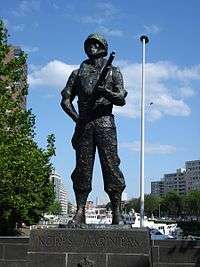
Some Mariniers later joined the Princess Irene Brigade to fight against the Germans. They distinguished themselves in combat near the Dutch city of Tilburg in the autumn of 1944.
Starting in 1943, the United States Marine Corps trained and equipped a new brigade, the Mariniersbrigade, of the Korps Mariniers at Camp Lejeune and Camp Davis in North Carolina in preparation for amphibious landings against the Japanese in the Dutch East Indies. The Japanese surrendered before such landings were needed, but the Mariniersbrigade, fully trained and equipped, left North Carolina in six transports in 1945 and fought against the Indonesians in their National Revolution for independence. It was part of the A Division, which was itself commanded by a Korps Mariniers officer. It was disbanded in 1949.
The Dutch kept Western New Guinea after the Indonesian National Revolution and the Korps Mariniers served there until 1962 when the colony in the course of the West New Guinea dispute was handed over to the United Nations Temporary Executive Authority.
Modern Korps Mariniers
On 11 June 1977, the Unit Interventie Mariniers (Marine Intervention Unit, UIM) of the Dutch Marine Corps stormed a train that was being held hostage since 23 May by armed South Moluccan nationalists in the village of De Punt, in the province of Drenthe. Six Royal Netherlands Air Force F-104 Starfighters buzzed the train as a diversion just before the assault. Six terrorists and two hostages were killed in the storming. The BBE [Bijzondere Bijstands Eenheid, Special Support Unit to the justice department, i.e. heavy weapons] has become the Dutch government's primary counter-terrorism force.
Lately the Marines have been deployed in various operations all over the world.
18 February 1992 – 18 November 1993: United Nations Transitional Authority in Cambodia (UNTAC).
- Three battalions of Marines and a Navy field hospital (FDS) were stationed in Cambodia following the 1991 Paris peace treaty when the civil war was ended.
1995–present: Former Yugoslavia, Bosnia, Kosovo.
28 July 2000 – 7 February 2003: United Nations Mission in Ethiopia and Eritrea (UNMEE).
11 January 2002 – July 2010: deployment in Afghanistan.
- Marines were deployed in Afghanistan as part of the International Security Assistance Force (ISAF) on several occasions. The second battalion with the field hospital was deployed in Mazar-e Sharif in 2005 to provide security during the elections. Marines and Navy personnel were also stationed in the Provincial Reconstruction Team in pol-e-Khomri, province of Baghlan. They took over from the Dutch Airforce and Army in 2005 and were relieved in October 2006 when Hungarian forces took over. Formerly Marines have served in Uruzgan as NLD Operational Mentor and Liaisons Team, for recruiting and training new military personnel of the Afghan National Army in the Uruzgan province. Training took place at Kamp Holland, Tarin Kowt. A reinforced company was deployed in the Deh Rashan area of Uruzgan province. Two marines were killed on April 17, 2010, their BvS 10 Viking was hit by an IED.[1]
1 August 2003 – 2004: deployment in Iraq.
- Two battalions of marines were sent to Iraq after the second Gulf war as part of the stabilisation Force Iraq (SFIR). They were stationed in the province of Al-Muthanna where they fell under British command. Main base was located at camp Smitty in As Samawah. One company of marines was located at the village of Ar Rumaythah and one at the village of Al Khidr.
18 November 2003 – 19 February 2004: United Nations Mission in Liberia (UNMIL).
- One platoon of Dutch marines was deployed on board HNLMS Rotterdam, a Landing platform dock (LPD) of the Royal Netherlands Navy to provide logistical support for UNMIL landforces.
2005–2006: United Nations Organization Mission in the democratic Republic of the Congo (MONUC)
- Major General of the Marines Patrick Cammaert was appointed division commander by UN secretary general Kofi Annan.
The Corps celebrates its birthday each year at the Oostplein (lit., East Square) in Rotterdam, where all fallen (ex) corpsmembers are remembered.
On 29 May 2009, Marco Kroon, a member of the Korps Commandotroepen and a former member of the Netherlands Marine Corps, was awarded the Military William Order, the highest military decoration in The Netherlands.
Structure

All operational units of the Netherlands Marine Corps fall under the Marine Training Command (MTC). A brigade level command element the "Netherlands Maritime Force" (NLMARFOR) is the deployable operational staff Headquarters which is commanded by a Colonel NLMC. The major combat elements of NLMARFOR are two battalion sized units called "Marine Combat Groups" (formerly known as Marine Battalions). The 1st Marine Combat Group is the main contribution of the Netherlands Marine Corps to the United Kingdom/Netherlands Landing Force (UK/NL LF).[2]
Netherlands Maritime Force
The Netherlands Maritime Force structure is as follows:
- Maritime Force Command Staff"
- 1st Marine Combat Group
- Command Staff
- 10th Reconnaissance, Surveillance and Target Acquisition Squadron (10 RSTA Sqn)
- 11th (Parachute) Raiding Squadron (11 (Para) R Sqn)
- 12th Raiding Squadron (12 R Sqn)
- 13th Raiding Squadron (13 R Sqn)
- 14th Combat Support Squadron (14 CS Sqn)
- 15th Combat Service Support Squadron (15 CSS Sqn)
- 2nd Marine Combat Group
- Command Staff
- 20th Reconnaissance, Surveillance and Target Acquisition Squadron (20 RSTA Sqn)
- 21st Raiding Squadron (21 R Sqn)
- 22nd Raiding Squadron (22 R Sqn)
- 23rd (Parachute) Raiding Squadron (23 (Para) R Sqn)
- 24th Combat Support Squadron (24 CS Sqn)
- 25th Combat Service Support Squadron (25 CSS Sqn)
Each Marine Combat Group is commanded by a Lieutenant Colonel and fields 726 men, with the Command Staff consisting of 30 men.
The RSTA Squadron is commanded by a Major and consists of 87 men: the RSTA squadron staff acts also as the Joint Fires Cell for its Marine Combat Group coordinating all types of fire support. Each RSTA Sqn fields a forward Observer Troop with four Fire Support Teams of six men each, an Unmanned Aerial Vehicle System section with AeroVironment RQ-11 Raven UAV's, a Reconnaissance Sniper Troop, a Mortar Troop with L16 81mm mortars and a Low Altitude Air Defense section.
The Raiding Squadrons are commanded by Majors and consist of 108 men. The Raiding Squadrons each field three Raiding Troops with two Raiding Sections of 16 men each per troop.
The Combat Support Squadron consists of 114 men and a besides its staff fields an Assault Engineer Troop, an Anti-Armour Troop and an Armoured All Terrain Vehicle Troop. Each of these three troops fields three identical sections, with each section supporting one Raiding Squadron of the Marine Combat Group. The Assault Engineer Troop also provides Improvised Explosive Device detection capabilities. The Anti-Armour Troop provides direct fire support with Spike Anti-tank guided missiles. The Armoured All Terrain Vehicle Troop provides BV206S and BVS10 armoured all-terrain personnel carriers to lift the three Raiding Squadrons.
The Combat Service Support Squadron fields 171 personnel and provide maintenance, medical and logistic support. Each Combat Service Support Squadron consists of a Workshop Troop, a Transport Troop, an Equipment Support Troop, a Medical Support Troop and a Communication and Information Systems Troop.
Maritime Special Operations Forces (MARSOF)
_with_FRISC_and_Cougars.jpg)
The Netherlands Maritime Special Operations Forces (NLMARSOF) are the Marine Corps elite units. The Maritime Special Operations Forces are divided into three squadrons and a Support Group. The Maritime Counter Terrorism Squadron (M Sqn) consists of two troops and is a special forces unit. The Conventional Squadron (C Sqn) is special operations unit operating mostly at sea, but also used as advance landing force in amphibious operations. C Squadron fields two troops, one specialized in underwater operations and the other trained in mountain warfare. C Squadron can be deployed by submarine, parachute, various underwater transport and snowmobiles. The Training Squadron (T Sqn) trains all men which are part of the Maritime Special Operations Forces. The Special Operations Forces Support Group (SOFSG) provides logistic support and equipment to the Netherlands Maritime Special Operations Forces.
The Maritime Special Operations Forces was created by merging the Mountain Leader Reconnaissance Platoon, the Unit Interventie Mariniers (M Sqn) and the Special Forces Underwater Operator (frogman-combat divers) platoon. The Maritime SF training takes about 40 weeks, and eligible marines are trained to become long-range reconnaissance/SF operators and maritime counter-terrorism specialists, with emphasis on maritime special operations (special operations conducted in water-rich environments, and conducted from sea to land). Those who wish to specialise for Mountain Leader or 'frogman' can apply for these specialisations following completion of the SF training. MARSOF is modelled after the British Special Boat Squadron.
Surface Assault and Training Group
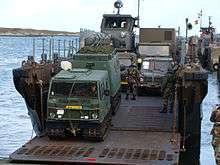
The Surface Assault and Training Group (SATG) provides the Marine Corps with maritime vessels. The Surface Assault and Training Group consists of 241 men; besides the staff it fields an Amphibious Support Group, a Landing Craft Utility (LCU) Troop, a Landing Craft Vehicle Personnel (LCVP) Troop, a Fast Raiding Interception and Special Forces Craft (FRISC) Squadron, a Landing Craft Control Team Light and a Landing Craft Control Team Heavy. The Amphibious Support Group provides logistical support for the SATG. The LCU Troop fields five Landing Craft Utility with their crews, while the LCVP Troop fields 12 LCVPs with their crews.
The FRISC Squadron fields three troops: a troop with Raiding Crafts for the Marine Combat Groups, a troop with Maritime Counter Terrorism Crafts (MCT) for the Maritime Counter Terrorism Squadron and a troop with Special Operation and Interceptor Crafts for the Conventional Squadron of the Maritime Special Operations Forces. The two Landing Craft Control Teams consist of a staff, a Beach Recce Group, a Beach Control Group and a Heavy Vehicle Group. The Landing Craft Control Team Heavy is equipped with Leopard 1 BARV beach armoured recovery vehicles. Both Beach Recce Groups field a team of divers to clear mines, barriers and other obstacles from landing beaches.
Seabased Support Group
The Seabased Support Group (SSG) fields 98 men and coordinates maritime operational logistic support for Marine units embarked on one the Rotterdam-class amphibious transport docks. The Seabased Support Group fields an Equipment Support Troop, a Weapons and Ammo Troop, a Workshop and Transport Troop and a Communications and Information Systems (CIS) Troop.
32nd Raiding Squadron (Dutch Caribbean Forces)
The 32nd Raiding Squadron (Dutch Caribbean Forces) consists 153 personnel and is stationed in Aruba and is responsible for the defence of the Netherlands Antilles. The 32nd Raiding Squadron falls operationally under the command of the Naval Commander of the Caribbean (CZMCARIB). 32nd Raiding Squadron is stationed at the Korps Mariniers Barracks Savaneta (Aruba). Marines on Aruba also participate in anti-drug operations. The squadron is commanded by a Major and consists of Headquarters, 3 Raiding troops and the following supporting units a Fast Raiding, Interception and Special Forces Craft (FRISC) troop (with 12 boats), and a combat service support troop for transport, logistics, maintenance and medical care.
Recruitment and Training
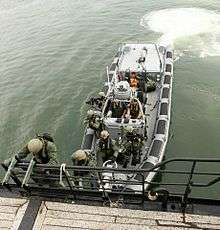
The Korps Mariniers are known for their arduous training programmes, which are primarily focused around hardship. Due to its longstanding and close coöperation with its British counterpart, the Royal Marines, training programmes are highly similar for both organisations. Although women have been allowed to join the Korps Mariniers since the beginning of 2017, no woman has successfully completed basic training yet.
Depending educational background, there are two career possibilities to become a Dutch marine: enlisted marine and marine officer.
EVO (Elementaire Vakopleiding): Initial training to become an enlisted marine in the Netherlands lasts about 33 weeks (8 months – roughly equivalent to that of the British Royal Marines). It is given at the Mariniers Opleidingscentrum (M.O.C.) at the Van Ghentkazerne in Rotterdam. It is rigorous and very demanding, both physically and mentally, and eventually 30% to 50% will pass. If successfully completed, the recruits receive their "dark blue beret", and will be assigned to the operational units of Mariniers Training Command (MTC).
VVO (voortgezette vakopleiding): Training to become a marine corporal lasts around 20 weeks. After 4–5 years of experience, marines who exhibit remarkable qualities can apply for this course, where they are being tested on leadership qualities and various military skills. Prior to the actual course, these marines will receive course segments, like marksman instructor, at an earlier stage.[3] Only through experience can a marine corporal grow into sergeant.
POTOM (Praktische Opleiding tot Officier der Mariniers - officer training): Initial training to become a marine officer in the Netherlands lasts a total of 22 months, starting with an intensive 11 months of practical marine officer's training and followed by 11 months of theoretical background and practical courses. The training is regarded as one of the most demanding initial military training programmes globally, with usually more than 70% of prospective officers dropping out.[4] This part of the initial training programme is modular, which means that it is made up of 4 phases. First, the prospective officers will learn the basic skills of every enlisted marine, which takes about 10 weeks. After phase one comes the second phase, commanding a raiding section of 14 marines. This module lasts for 8 weeks, and emphasizes nightly operations. After successfully completing the second phase the third phase commences, which is focused on commanding a raiding troop of 32 marines. The fourth phase centers around commanding a raiding troop in different domains (e.g. urban, maritime setting). The last two modules are the longest, and cross-training is provided by both the Korps Mariniers and the British Royal Marines officer training teams. When successfully completing the 'POTOM', candidates are required to complete another year of general officer's training at the Koninklijk Instituut voor de Marine (Royal Dutch Naval Academy). Once this has been finished, the marine officer will be assigned to one of the operational units within the Marine Training Command (MTC).
Operational training
During operational training, there is more emphasis on various other tactics in amphibious warfare, and it will take about a year to become MARSOC (Maritime Special Operations Capable) certified, which will last for two years. SOCs are able to operate within any environment in the world, under any condition and circumstance. Therefore Dutch marines regularly train in arctic, jungle, desert, high-altitude, maritime and urban conditions, and embark on various training missions throughout the world. In these two years SOCs will work closely with MARSOF platoons throughout the world, and can choose to enlist for further specialization.
Specialisation
Experienced marines are able to obtain various specialisations. It is common for marines to have multiple specialisations. Popular specialisations include:
- Weapons Instructor
- Sports or PT Instructor
- Mortar specialist (81mm mortar)
- Radio specialist
- Air Defence specialist
- Marksman
- Sniper
- Heavy Weapons specialist
- Marine Scout
- Assault Engineer
- Combat Life Saver
- Medic
- Free-fall parachutist
- Force Reconnaissance ("pathfinder")
- Special Forces (the Mountain Leaders, Frogman and Unit Interventie Mariniers platoons) have merged, creating the Netherlands Maritime Special Operations Force (NLMARSOF). To become a NLMARSOF operator, SOC marines will follow a special forces training course, which takes about a year, after which they are CT specialists. They then join M-Squadron or specialise further for C-Squadron as mountain leader or frogman. These courses are considered to be one of the toughest in the world, and around 60% of NLMARSOF operators will not make it. After completing the frogman course usually the two best graduates will actually get to join the frogman unit. The others will use their skills within M-Squadron.[5]
Some of these specialisations require the rank of Corporal before being able to follow specialisation training, and must not exceed a maximum age.
Equipment

Armour
- 156 BV206 all-terrain personnel carriers(127 will get a Mid-Life Update, the rest will be disposed of or sold)[6]
- 74 BVS10 armored all-terrain personnel carriers[7]
- 4 Leopard 1 BARV beach armored recovery vehicles
- Iveco LMV-2 AFV on order
- Patria XA-188 Designed to carry personnel or materiel and for conducting patrols.[8]
Landing craft
- 5 LCU Mk. II – Landing craft utility [9]
- 12 LCVP Mk5c – Landing craft vehicle personnel[10]
- 48 Fast Raiding, Interception and Special Forces Craft, 11 for Special Operation use, 12 for use in the Dutch territories in the Caribbean, 17 for use as small landing crafts and 6 to use in combination with the new Holland Class OPV's
- Landing Craft Rubber (Motorized)
Other vehicles
- Land Rover Defender
- 40 Mercedes-Benz 280 CDI
- Volkswagen Amarok successor of both the Mercedes G-class as the Land Rover Defender, entering service from 2014 onward.[11]
- 17 Unimog 1.2-ton truck
- Various DAF & Scania trucks
Weaponry
Small arms
| Name | Type | Origin | Chambering | Notes |
|---|---|---|---|---|
| Heckler & Koch HK416 | Assault rifle | 5.56×45mm NATO | Only used by MARSOF units, 10" and 14.5" barrel variants. | |
| SIG Sauer MCX | Carbine | .300 AAC Blackout | Integrally suppressed. Only used by MARSOF units. | |
| Colt C7NLD | Assault rifle | 5.56×45mm NATO | Service rifle | |
| Colt C8NLD | Carbine | 5.56×45mm NATO | ||
| Colt Canada LOAWND | Squad automatic weapon | 5.56×45mm NATO | ||
| Heckler & Koch UGL | Grenade launcher | 40×46mm | ||
| Glock 17M | Semi-automatic pistol | 9×19mm Parabellum | M stands for Maritime springs cups | |
| Mossberg 590 | Pump-action shotgun | 12 gauge | ||
| Name | Type | Origin | Chambering |
|---|---|---|---|
| Accuracy International Arctic Warfare | Sniper rifle | 7.62×51mm NATO | |
| Accuracy International AWSM-F | Sniper rifle | .338 Lapua Magnum | |
| Barrett M82A1 | Anti-materiel rifle | .50 BMG (12.7×99mm NATO) |
Support/ remaining
| Name | Type | Origin | Chambering |
|---|---|---|---|
| FN MAG | General-purpose machine gun | 7.62×51mm NATO | |
| M2 Browning | Heavy machine gun | .50 BMG (12.7×99mm NATO) | |
| Heckler & Koch AGW | Automatic grenade launcher | 40×53mm | |
| L16 | Mortar | 81mm | |
| Brandt MO-60-V | Mortar | 60mm | |
| FIM-92 Stinger | Man-portable surface-to-air missile | ||
| Panzerfaust 3 | Anti-tank rocket launcher | ||
| GILL | Anti-tank missile | ||
United Kingdom/Netherlands Amphibious Force (UK/NL AF)
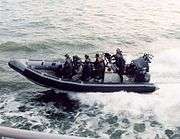
Since 1972,[12] units of the Netherlands Marine Corps have formed part of the British 3 Commando Brigade during exercises and real conflict situations. Also Mountain Warfare /Force Reconnaissance Troop of C Squadron NLMARSOF will be placed under UK operational command as part of C Squadron, UK Special Boat Service. Together, these form the UK/NL AF. Either the First or the Second Marine Combat Group can be assigned as the Dutch contribution to this force. UK/NL AF contributes to the European Multinational Maritime Force (EMMF).
The cooperation between the Korps Mariniers and the Royal Marines has led to extensive integration in the areas of operations, logistics and materials. Within NATO this is seen as a prime example of what can be achieved in military integration.
The NLMC and Royal Marines have a long history of cooperation. During combined actions by the British and Dutch navies during the War of the Spanish Succession (1702–1713), amphibious operations were carried out, the most notable being the Capture of Gibraltar in 1704. During this action, a successful attack was carried out against the fortress of Gibraltar by an 1800-strong brigade of Dutch and British Marines under the command of Prince George of Hesse-Darmstadt. Both corps share this battle honour.
The British and Dutch armed forces share close relations. The Royal Marines and Netherlands Marine Corps are allied through a 'Bond of friendship'.
The nickname of the Dutch Marines among their British Royal Marine counterparts is "Cloggies," due to the stereotype that most or all Dutch wear clogs, instead of "normal" footwear.
Alliances



Notes
- "wo Dutch marines have been killed in Uruzgan province in Afghanistan". Rnw.nl. 2010-04-17. Archived from the original on 2012-04-05. Retrieved 2012-01-19.
- http://korpsmariniers.com/eenheden
- "Brandnew cadre members Korps Mariniers".
- "Look behind the scenes at the officers training of the marines". Retrieved 2017-10-13.
- "Frogman(Kikvorsman) training". Retrieved 30 June 2017.
- "Bandvagn 206-rupsvoertuig". defensie.nl. Retrieved 19 March 2016.
- "Bandvagn S10-rupsvoertuig (Viking)". defensie.nl. Retrieved 19 March 2016.
- "Archived copy". Archived from the original on 2015-12-22. Retrieved 2015-11-08.CS1 maint: archived copy as title (link)
- "Archived copy". Archived from the original on 2014-10-19. Retrieved 2014-10-14.CS1 maint: archived copy as title (link)
- "Archived copy". Archived from the original on 2014-10-19. Retrieved 2014-10-14.CS1 maint: archived copy as title (link)
- "New vehicles for the armed forces". defensie.nl. Retrieved 19 March 2016.
- https://www.defensie.nl/onderwerpen/internationale-samenwerking/inhoud/maritiem-en-amfibisch/brits-nederlandse-samenwerking-mariniers
References
- Beknopte geschiedenis Korps Mariniers
- Klein, Edwin,'The Dutch Marines and the Indonesian Problem', Marine Corps Gazette, Aug 1946.
- Dorren, C.J.O., De geschiedenis van het Nederlandsche Korps Mariniers van 1665–1945, 's Gravenhage, 1948.
- Coox, Alvin D., 'The Dutch Invasion of England: 1667', Military Affairs, Vol. 13 No. 4, Winter 1949, pp. 223–233.
- Dorren, C.J.O., 'Een historische terugblik op de ontsluiting van Japan na de maritieme strafexpedities tegen Kagoshima en Simonoseki (1863–1864)', Marineblad, 1950.
- Edwards, H. W., 'Netherlands Korps Mariniers', Marine Corps Gazette, Sep 1953.
- Dorren, C.J.O., Onze mariniersbrigade (1945–1949). Een veelbewogen episode in de korpsgeschiedenis, 's Gravenhage, 1955.
- Strandberg. Carl, 'Netherlands Marines', Marine Corps Gazette, Dec 1961.
- Bosscher, Ph. M., 'De gezantschapswacht te Peking', Marineblad, Vol. 75, 1965, pp. 1145–1198.
- Middelhoff, A.J.M., 'De geschiedenis van het 1ste Bataljon Marinetroepen', Marineblad, Vol. 79, 1969, pp. 627–642
- de Korver, Michael, 'Royal Netherlands Marines belong to the world's second oldest marine corps', Marine Corps Gazette, Feb 1979.
- Scharfen, 'Het Korps Mariniers' (interview), Marine Corps Gazette, Oct 1987.
- Schoonoord, D.C.L., De Mariniersbrigade 1943–1949 Wording en inzet in Indonesië, Instituut voor Maritieme Historie, The Hague, 1988.
- van Holst-Pellekaan, R.E., de Regst, I.C. and Bastiaans, I.F.J, Patrouilleren voor de Papoea's: de Koninklijke Marine in Nederlands Nieuw-Guinea 1945–1960, Amsterdam, 1989.
External links
| Wikimedia Commons has media related to Netherlands Marine Corps. |